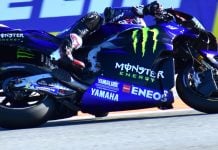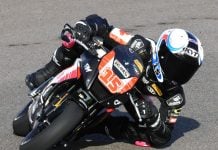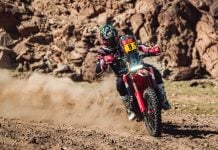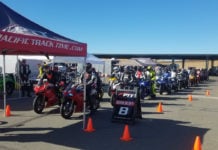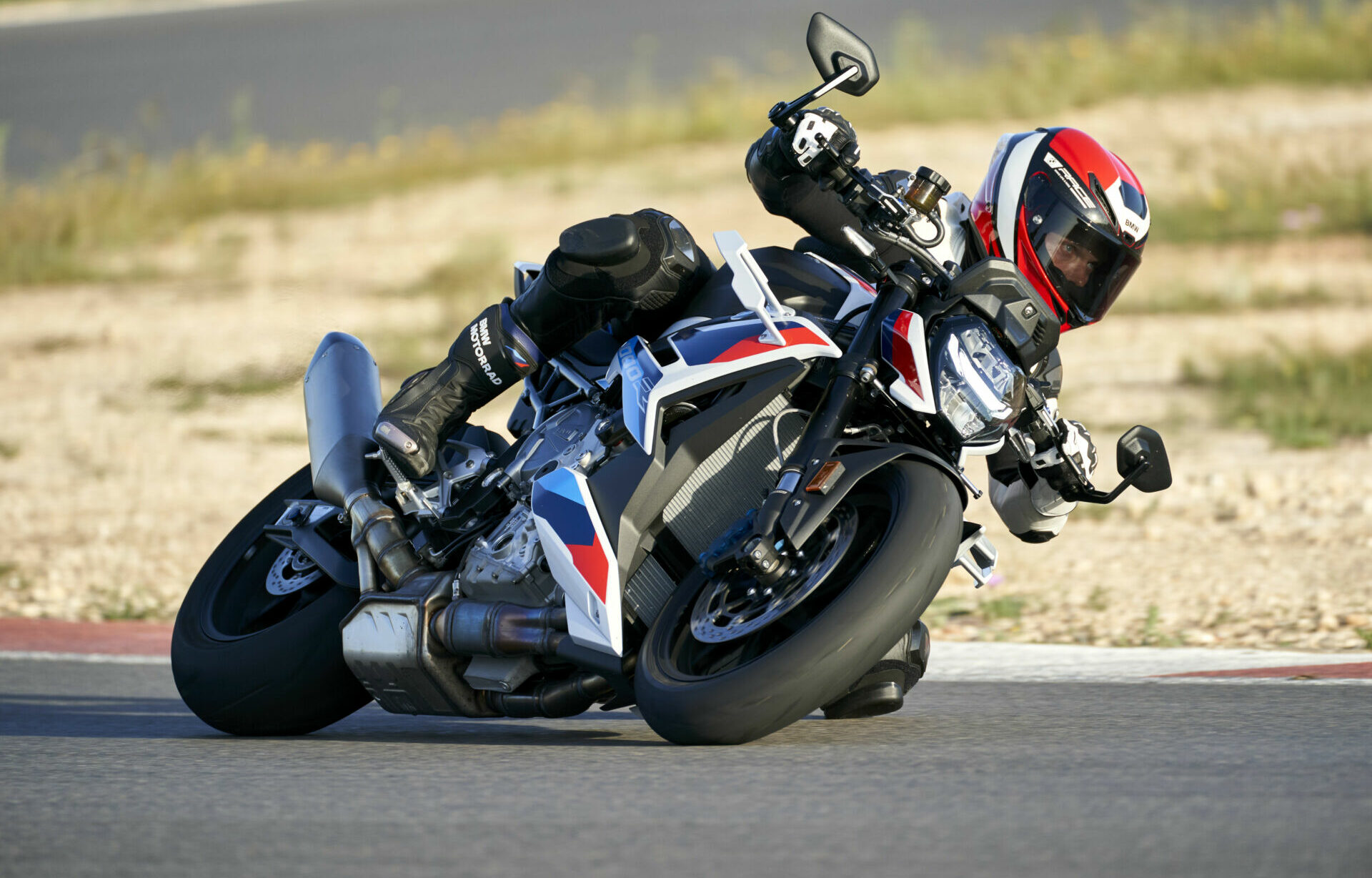The new 2023 BMW M 1000 R
The first M Roadster from BMW Motorrad and M Motorsport.
205 hp and 83 lb-ft of torque.
MSRP of $21,345 plus $695 Destination
Expected U.S. market arrival – January 2023
Woodcliff Lake, NJ – October 11, 2022…BMW Motorrad proudly introduces the first M Roadster and the second model in the 2-wheel M Motorsport lineup.
“The M R is the second M model from BMW Motorrad. Based on the current S 1000 R and S 1000 RR, the product substance of the M 1000 R – M R for short – has been tuned to meet the specific requirements of a supersport roadster. The riding dynamics speak for themselves both on the country road and on the track.” Ralf Mölleken, Project Manager 4-cylinder models
At the end of 2018, BMW Motorrad introduced the successful M Motorsport automobile range strategy to its motorcycle brand and has since been offering M special equipment and M Performance Parts on various BMW models. The new 2023 BMW M 1000 R – M R for short – is the second M model from BMW Motorrad to celebrate its world premiere, following the M 1000 RR superbike.
During the 50th birthday of BMW M GmbH, BMW Motorrad is adhering to the M brand philosophy of the most powerful letter in the world with the new M R: M is synonymous with racing success as well as high-performance street BMW models and is aimed at customers with particularly high demands for performance, exclusivity and individuality. With an engine output of 205 hp, a weight of 438.7 pounds, and suspension technology and aerodynamics designed for both high-performance street track use, the new M R delivers a dynamic riding experience in the roadster segment previously reserved for superbikes.
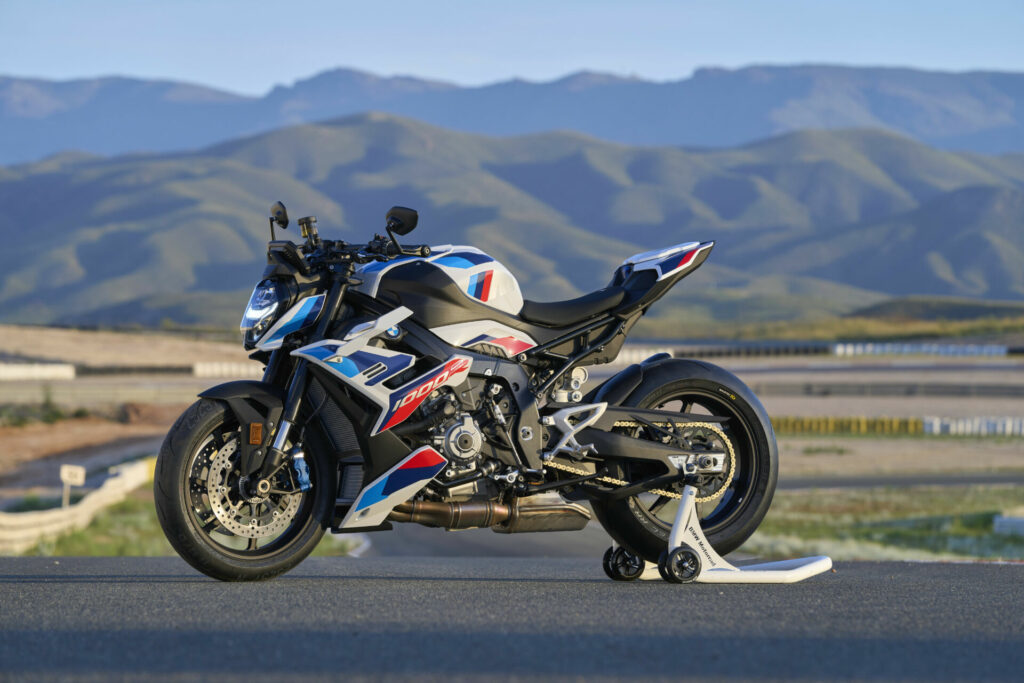
The highlights of the new BMW M 1000 R
999 cc 4-cylinder, shift cam engine.
205 hp at 13,500 rpm, 40 hp more than in the S 1000 R.
83 lb-ft. of torque at 11,000 rpm.
Shorter secondary gear ratio (sprocket with 47 teeth instead of 45)
Shorter gear ratios of 4th, 5th and 6th gear.
Optimized intake with variable intake funnels for improved flow at high rpm.
Sport exhaust with titanium rear silencer.
M Endurance chain.
Riding modes “Rain”, “Road”, “Dynamic”, “Race” and “Race Pro1- 3” as well as the latest generation of Dynamic Traction Control DTC and DTC wheelie function with 6-axis sensor box. – Three adjustable throttle characteristics available now for optimum response. “Engine Brake” with triple adjustability of engine drag torque in “Race Pro” mode.
Brake Slide Assist assists the rider when brake drifting.
Shift Assistant Pro for fast upshifts and downshifts without using the clutch and easily reversible shift pattern.
Launch Control for perfect race starts and Pit Lane Limiter for precise pit lane speed control.
Hill Start Control Pro for comfortably starting off on inclines.
M winglets and wind deflectors: Brake later and accelerate earlier, plus more high-speed stability thanks to aerodynamic downforce.
Engine spoiler.
Upside-down fork in “All black” design with adjustable spring base in conjunction with standard DDC Dynamic Damping Control.
M brakes on a Dynamic Roadster from BMW Motorrad for the first time: The M R offers maximum braking performance for street and track.
Aluminum forged alloy wheels.
Optional M Carbon wheels with M graphics.
M handbrake and clutch lever.
Adjustable steering damper.
Milled handlebar clamp.
Compared to the S 1000 R, wider tubular handlebars with laser etched “BMW M 1000 R” lettering.
Handlebar end mirrors.
LED headlamp with illuminated M logo.
Smaller license plate bracket.
Instrument cluster with large, easy to read 6.5-inch TFT display, start-up animation with M logo and OBD interface for M GPS Datalogger and M GPS Laptrigger that can be used via activation code.
Rev counter (red area) displayed in a new design.
Lightweight M battery, rear USB charging socket, LED lights, electronic cruise control and heated grips.
Keyless Ride.
RDC tire pressure monitor..
Extensive range of optional accessories
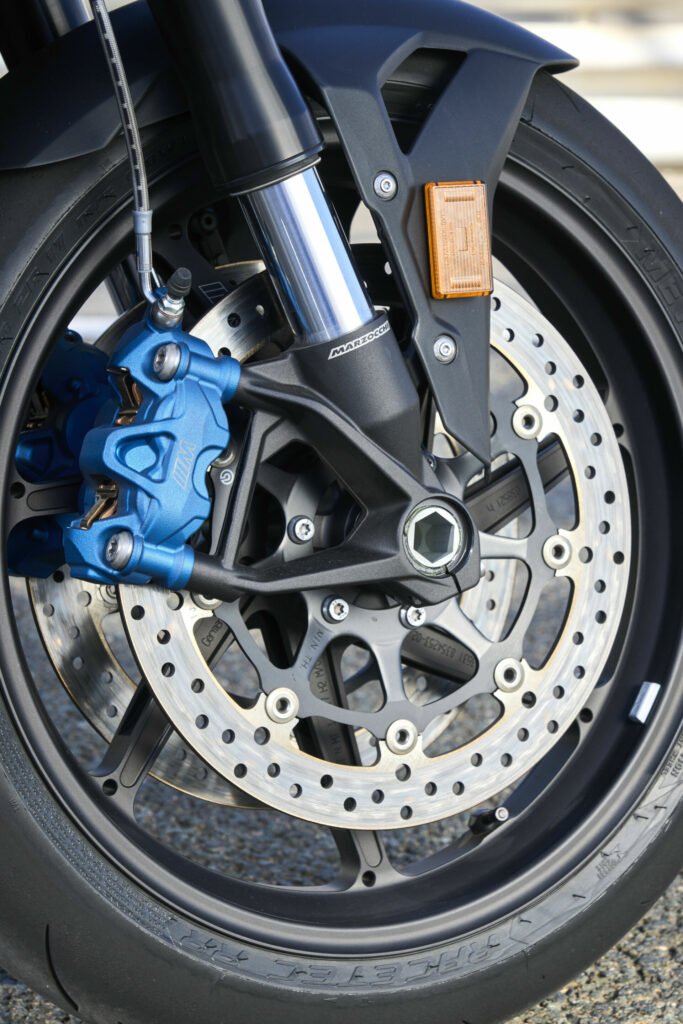
1. ENGINE AND CHASSIS
“With the engine of the M 1000 R, we have achieved a technical balancing act. For super-sporty country road use, a pleasant power characteristic with plenty of torque in the low and medium rev range is available, while high peak power is provided for riding on the track. The significantly improved acceleration and pulling power values are immediately noticeable to the rider.” Ralf Möllleken, Project Manager M 1000 R
The new M R uses the water-cooled 999 cc, 4-cylinder in-line engine developed from the M RR. It delivers 205 hp at 13,500 rpm (40 hp more than in the S 1000 R) and 83 lb-ft. of torque at 11,000 rpm. Compared to the S 1000 R, the maximum engine speed has been increased from 12,000 rpm to 14,600 rpm.
From 10,000 rpm to 12,000 rpm for example, noticeably more torque and thus acceleration power is available, which is relevant for supersports riding as well as during track use.
From 10,000 rpm, the engine of the new M R shows its advantages and provides much more peak power and torque until the redline. Increased rear wheel traction in all gears is also provided by a shorter secondary gear ratio through the use of a sprocket with 47 teeth (S 1000 R: 45 teeth). In addition, the gear ratios of the 4th, 5th and 6th gear have been changed.
BMW ShiftCam technology
With the aim of generating significantly increased peak power as well as achieving optimum power delivery across the entire rev range relevant for supersports riding on the street and on the track, the intake ducts have also been redesigned as in the M RR. Compared to the S 1000 R, they feature advanced channel geometry and are designed to achieve the best possible flow.
BMW ShiftCam technology is used to vary the valve timing and valve lift on the intake side. This is a three-part intake shift camshaft that has two cams mounted on a shift segment for each valve to be actuated: a torque cam and a power cam, each with optimally designed cam geometry. As with the S 1000 RR, the shift speed of the BMW ShiftCam on the M R is 9,000 rpm. Below 9,000 rpm, shifting is load-dependent and when a higher torque is required, the shift is made to the torque cam.
By means of an axial displacement of the cam segment, the inlet valves are shifted from either the torque cam or the power cam in just 10 milliseconds, depending on the load and speed. The axial displacement of the cam segment and thus the use of torque or power cam is affected via two shift cams on the cam segment and two electromechanical actuators. The different design of the cam geometry is used to vary the timing and the valve lift. While the full-load cam provides maximum valve lift, the partial-load cam delivers reduced valve lift.
The benefits of BMW ShiftCam Technology include:
Increase in torque and pulling power in the low and medium speed range with simultaneous gain in peak power.
Optimal design of the part-load cam geometry for the lower to medium load and speed range.
The new MR engine offers almost the same high torque range in the lower and middle ranges as the previous S 1000 R engine, but with the same peak power as the RR.
Reduction of load change loss in the partial load range.
Reduction of exhaust emissions and optimized sound.
Titanium valves, lighter cam followers and optimized camshafts
The M R also uses four valves made of lightweight titanium for each combustion chamber. The stems of the inlet valves feature a hollow-bore design to minimize weight. The valves are operated via light, DLC-coated cam followers. In the M R, the camshafts are driven directly from the crankshaft without an intermediate gear. The primary reduction gear for halving the speed of the camshafts is located directly in the cylinder head.
Light, compact engine with wet sump lubrication
As before, the cylinder liners integrated into engine block are polish-slide-honed to reduce friction, and the oil and water pumps are combined into a single compact module. The tubing of the water and oil cooling circuit is reduced to a minimum and designed to be very resistant to falls, in keeping with the spirit of a racing engine. To achieve the smallest possible overall width, there is only one gear wheel on the crankshaft, as the primary reduction gear of the starter engages directly with the primary gear wheel of the clutch. The starter motor is integrated on the top of the housing behind the cylinders. The crankshaft position is detected via the rotor/generator.
As in the RR, the oil supply is of a wet sump design. For the sake of maximum operational safety, the oil pan keel and thus the suction point of the pump is very low. The anti-hopping clutch is operated from the right-hand side of the engine. On the M R as well, the upper half of the housing accommodates the light, compact and precise 6-speed gearbox with Pro Shift Assistant.
Intake system with shorter intake funnels
The new M R also has a so-called full E-throttle “electronic throttle grip” for pleasantly low operating forces and precise engine control. The M R engine is equipped with variable intake funnels. The length of the intake funnels is varied in two stages by a map-controlled servomotor mounted on the airbox. At 11,000 rpm, the short intake paths, for improved maximum power, are opened.
New lighter Sport exhaust system with titanium silencer
The BMW Motorrad engineers pursued the overriding goal of further increasing the new M R’s power and torque delivery compared to the S 1000 R, while at the same time reducing weight for the new exhaust system. The new standard Sport exhaust system features two three-way catalytic converters and a titanium rear silencer. An M Titanium front silencer system including manifold is also available as an accessory.
Improved performance and acceleration across the rev range
The new M R engine is significantly more powerful than the 4- cylinder of the S 1000 R across the entire rev range. Acceleration and pulling power have been noticeably increased. With an acceleration speed of 7.5 seconds to 124 mph, the M R is 0.5 seconds faster than the S 1000 R. The picture is even more dramatic with regard to the pullthrough values, measured in 6th gear. While the S 1000 R takes 3.3 seconds from 37 mph to 62 mph, the M R only needs 2.9 seconds. The intermediate sprint from 62 mph to 93 mph takes 2.5 seconds (S 1000 R: 3.3 seconds) and in the interval between 87 mph and 112 mph is 2.8 seconds (S 1000 R: 4.0 seconds).
The new M R engine is much more powerful than the S 1000 R engine in the range from 10,000 rpm to 14,600 rpm, which is particularly relevant for dynamic riding on the track, but without losing its superior qualities as an excellent street machine.
Riding modes
With the new M R, a distinction is made between two riding mode worlds: One for street and one for the track. The new M R features four street riding modes “Rain”, “Road”, “Dynamic” and “Race” as standard, as well as the additional track riding modes “Race Pro 1”, “Race Pro 2” and “Race Pro 3”. The latest generation of Dynamic Traction Control (DTC) with 6-axis sensor cluster, lean angle sensor and fine adjustment for even more safety and performance when accelerating is standard.
The DTC has four fixed basic settings for the respective riding modes “Rain”, “Road”, “Dynamic” and “Race” as well as the DTC wheelie function. In the “Race Pro” riding modes, fine adjustment (+/- Shift) is also available. The DTC wheelie function is adjustable. It allows wheelies to be suppressed or limited with the aim of maximum acceleration via the front wheel lift-off detection.
Adjustable throttle maps and engine drag torque control
The new M R features three standard throttle maps linked to each of the riding modes “Rain”, “Road”, “Dynamic”, “Race” and “Race Pro”. The newly added third throttle characteristic “Direct Throttle Response” with a very steep gradient for more spontaneous response is configurable in “Race Pro” mode. The “Engine Brake” feature in “Race Pro” mode also offers triple adjustability of the engine drag torque in overrun mode.
Rain: Soft throttle response, reduced drive torque in the lower gears.
Road: Optimum throttle response, reduced drive torque in the lower gears.
Dynamic: Optimum throttle response, reduced drive torque in the lower gears.
Race: Optimum throttle response, maximum drive torque in all gears.
Race Pro 1-3: Fully configurable.
Shift Assistant Pro
Shift Assistant Pro enables upshifting without clutch actuation and thus offers acceleration almost without interrupting traction. It also allows downshifting without clutch or throttle actuation in the load and speed ranges relevant for riding. This allows very fast gear changes and reduces clutch use to a minimum. For use on the track, the conventional shift pattern “first gear down” can be changed in a few simple steps to “first gear up.”
Launch Control and Pit Lane Limiter
The new M R also offers Launch Control, which actively supports the rider during race starts. It can be activated at a standstill with the engine running and at idle speed by pressing the start button for more than three seconds. The Pit Lane Limiter allows the rider to limit speed for pit lane riding in any riding mode.
Hill Start Control Pro
The new M R already features standard Hill Start Control Pro. It goes beyond the features of the Hill Start Control by offering an additional Auto HSC function. The settings menu allows this extra function to be individualized in such a way that the holding brake is automatically activated on a gradient (greater than +/- 5 %) when the handbrake or foot brake lever has been activated, shortly after stopping.
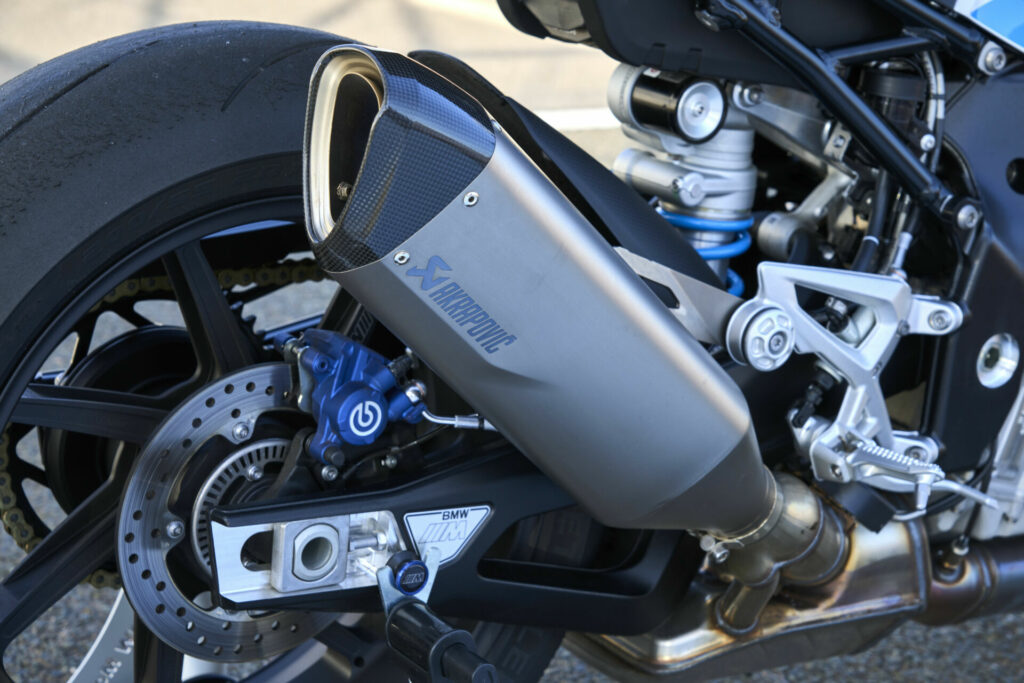
2. SUSPENSION AND AERODYNAMICS
“In order to put the high performance of the M 1000 R on the road, we had to apply some measures to the suspension and chassis. The M winglets, a front-wheel oriented seating position and a tire developed exclusively for the M R ensure maximum stability and riding enjoyment. M brakes, used for the first time on a dynamic roadster, helps keep the M R in check.” Sebastian Epp, suspension development M 1000 R
The significantly increased potential of the new M R compared to the S 1000 R is not only reflected in the high-performance drivetrain technology. In fact, the outstanding riding dynamics are largely the result of consistent development work on the suspension and aerodynamics, with countless test rides on the street, on the track, as well as tests in the BMW Group wind tunnel.
M Winglets
In addition to drive and suspension technology, aerodynamics was also a key item in the development of the M R. The new M R was given winglets on the front side panels with the aim of achieving even faster lap times on the track and the best possible riding stability at high speeds. At a speed of 136 mph, they provide an increase in front wheel load of approx. 22 pounds of downforce. An additional substructure, invisible from the outside, ensures optimal transmission of the downforce generated by the winglets.
The winglets, which have become indispensable in racing series such as MotoGP or the Superbike World Championship, also serve in achieving the best possible contact between the wheels and the road surface – especially when accelerating and at high speeds. Wheelies are undesirable from a riding dynamics point of view, as the drive force in a wheelie is not converted 100 percent into propulsion but wasted on the rising of the front end of the motorbike. Accordingly, the traction control kicks in to stop the wheelie and thus reduces the driving force. Valuable tenths of a second are lost here.
The additional downforce load on the front wheel counteracts this wheelie tendency during acceleration, meaning the traction control system has to regulate less and thus more drive power is converted into acceleration and the rider achieves a faster lap time.
The BMW Motorrad developers countered the slightly increased aerodynamic resistance caused by the small additional frontal area and shape of the M winglets with a correspondingly designed wind deflector (only in the M Competition Package). It provides improved airflow around the rider’s helmet, relieves the rider’s upper body at high speeds and compensates for the slight increase in drag caused by the winglets with the aim of achieving a higher top speed.
Suspension and chassis
The suspension and chassis of the new M R are based on the S 1000 R with the aluminum bridge frame as the centerpiece. It is a welded construction consisting of four gravity die-cast sections and integrates the engine, which is inclined forward by 32 degrees, as a supporting element.
The frame, known as the “Flex Frame” due to the optimal interaction of the main frame, rear frame and swinging arm, offers further advantages thanks to its very narrow design. This considerably reduces the width of the motorcycle in the area relevant for good knee closure. The rider benefits from being able to keep their thighs together closer to the bike and thus maintain a more relaxed riding posture.
When designing the suspension of the new M R, the aim was to realize both the best possible lap times on the track and an exceptional riding experience on the street.
The front wheel is controlled by an upside-down fork with a 45 mm sliding tube diameter in “All black” design. The fork of the M R features an upper triple clamp with an elaborately milled handlebar clamp as well as a black aluminum tubular handlebar with a wider design than previously seen on the S 1000 R and with laser etched “BMW M 1000 R” lettering. Also new on the M R, are milled aluminum bar-end mirrors. The fork legs have also been modified and are now designed to accommodate the new M brake calipers. In addition, the M R features an adjustable steering damper.
The fork features adjustment options for the spring base as well as 10 tuning levels each for the damping rebound and compression stages. The sensitive response, the wide adjustment range and the very high damping reserves offer maximum riding dynamics and individual tuning options on the track. The total front suspension travel is 4.7 inches.
The central spring / shock has an adjustable spring base and adjustable damping for both rebound and compression. Rebound and compression damping are adjustable via the very user-friendly scaling of 10 steps each. The total rear suspension travel is 4.6 inches.
DDC Dynamic Damping Control
The new M R is equipped with the electronically controlled Dynamic Damping Control (DDC) suspension as standard.
The basic settings of the DDC are linked to the riding modes “Rain”, “Road”, “Dynamic” and “Race”.
In “Rain” and “Road” mode, the DDC’s tuning focus is on sporty-comfortable damping.
“Road” is tuned for streets with poor to good road surfaces.
“Dynamic” on the other hand, is intended for very well-maintained road surfaces.
“Race” is best for track use while “Race Pro” riding modes offer individually adjustable “Race” damping characteristics to help individualize your track riding. Here, the spring-damper elements provide the rider with optimum, clear feedback at all times with regard to the respective riding situation.
In addition, the suspension tuning can also be individualized in all riding modes. Like in the case of mechanical adjustment, the customer has the option of adjusting the suspension to softer or firmer simply by “pressing a button” in the configuration menu. Thus, DDC is also able to take into account how much load the new M R is carrying.
Accordingly, the rider can set the DDC setting in the configuration menu for riding solo (1 helmet) or with a passenger (2 helmets). A new feature of the M R’s DDC is the additional adjustability of the fork’s spring base.
M Brakes
Next to the M 1000 RR, the new M R is the second BMW motorcycle to feature the M brake system. It was developed directly using the experience gained with the racing brakes on BMW Motorrad factory racing machines in the Superbike World Championship. The result of this development work was the M brake system – offering maximum performance, pressure point and fade stability as well excellent response. The M brake calipers feature a blue anodized coating in conjunction with the M logo.
Together with two 320 mm / 12.6-inch brake discs of 5 mm / 0.2-inch thickness and black anodized aluminum brake disc carriers, the brake system equipped with a new radial hand brake pump currently marks the pinnacle of brake development in the field of road-legal systems. Two brake pad variants are available for different applications. One for road use and another compound from the World Endurance Championship for use on the track. Both brake pad compounds are matched to the ABS Pro functions. At the rear wheel, a single-piston floating caliper in M design, also anodized in blue, together with a 220 mm / 8.7-inch steel brake disc provide deceleration.
Lightweight Forged Aluminum and M Carbon Wheels
The new M R is equipped with very lightweight forged aluminum wheels as standard. The exclusive M Carbon wheels are available as part of the optional M Competition Package.
Carbon fiber, once developed for the aerospace industry, features high-strength and super-light construction and first established itself in racing. BMW Motorrad uses it wherever minimum weight and maximum strength are required. Less weight means lower rotational mass leading not only to improved acceleration and braking behavior but also makes the bike easier to handle. In short: The M Carbon wheels make the M R even more agile. In addition, the carbon fiber surface is covered with high-gloss clear lacquer that is characterized by its deep black shimmering structure.
Brake Slide Assist
The new Brake Slide Assist function is an important and very helpful innovation, especially for track riders. It allows the rider to brake drift into corners with a constant slide. From a technical point of view, a slip angle (drift angle) is set by limiting the brake pressure at the rear wheel by the ABS Pro system and by controlling the rear wheel slip by the engine drag torque control (MSR). Due to his position on the motorcycle and the application of force via the handlebars, the rider has a considerable influence on the drift behavior during braking. Brake Slide Assist provides support to the rider for this partially unstable driving condition of drifting and is only active in ABS Pro Setting “2”.
3. ELECTRONIC SYSTEMS
The 6.5-inch TFT instrument cluster of the new M R is essentially the same as that of the M RR. Four screens (Pure-Ride with the most important information and 3 Core Screens) allow the rider to choose the display according to their needs, including track riding. The diversity of available information, display quality and user-friendliness of the new instrument cluster are currently unrivalled in this segment
.
In addition to a wide range of functions and information, the BMW Motorrad developers placed particular emphasis on the best possible readability of the 6.5-inch TFT display. To ensure optimum readability even under difficult lighting conditions – the display was designed to be large and thus easy to understand. It is linked to the multi-controller on the left handlebar control unit and can be operated quickly, safely and conveniently. After turning the ignition on, the M logo appears prominently in the display.
The TFT display of the M R offers customized screen displays for different purposes. The Pure Ride screen, for example, provides all the necessary information for normal operation on the street, while the three Core screen displays are designed for the track and provide a corresponding range of information. In addition, the tachometer is displayed here both in analogue form (Core 1 and 2) and as a bar graph (Core 3).
The rev counter display itself has been improved and now has a dashed area and a solid red area that are directly controlled by the engine control unit. Dashed areas are to be avoided while the solid red area is locked off. This new display scheme applies, for example, to the warm-up period, the pit lane limiter and the launch control as well as the showroom mode and the temperature caution map. Another new function is the tachometer flashing in concert with the shift light when approaching the redline. In addition to the digital display of speed, rpm, selected riding modes, settings for ABS Pro and DTC as well as the menus, further information can be called up via the display:
Current left/right lean angle.
Maximum left/right lean angle.
Current deceleration achieved in m/s2.
Maximum deceleration achieved in m/s2.
Torque reduction through DTC.
Speed warning (display “SPEED” if a predefined speed is exceeded).
Average speed.
Average fuel consumption.
Trip 1 and 2.
Remaining range.
Odometer.
Fuel tank level.
For riders who take the new M R out on track, the instrument cluster offers further, highly useful data that can be called up in various display formats:
Lap time and lap distance.
Lap specific speeds (min, max, average).
Active riding mode per lap.
DTC setting value per lap.
Lean angle left/right.
Lean angle maximums left/right per lap.
Maximum DTC torque reduction per lap.
Maximum deceleration per lap.
Number of gear shifts per lap.
Average throttle grip position per lap.
Total laps, total riding time and total distance.
Best-ever lap.
The optional M GPS Laptrigger, part of the M Competition Package, provides predefined start/finish lines for more than 300 tracks around the world.
The electronics of the new M R are largely based on the proven systems of the S 1000 R. However, with a view to the highest possible performance, the M R has a Lightweight M battery weighing only 2.8 pounds with a capacity of 5 Ah. It also features a USB charging socket installed at the rear of the vehicle as standard, which provides a maximum charging current of 2.4 A. Electronic cruise control and heated grips for colder days are both standard.
The new M R features full LED lighting, including the headlight with illuminated M logo, the brake light, the front indicator lights and the instrument cluster. The LED headlamp with adaptive turning light gives the M R not only a highly dynamic look, but illuminates the road ahead very effectively, at all speeds.
Keeping with the “all in one” motto, the license plate bracket, which is short and light on the M R, and the indicator and license plate lights at the rear form a single unit, plus the brake light and taillight functions are integrated into the indicator lights. This extremely compact design also allows the M R to be made “ready to race” in just a few steps.
4. DESIGN
Even more than the S 1000 R, the new M R with improved suspension technology and the most powerful engine to date in a dynamic roadster from BMW Motorrad is uncompromisingly designed for sporty riding – whether on the street or on the track. The M R is the pinnacle of what is currently possible in the roadster segment. The proportions of the M R are ultra-compact and powerful and are both visually exciting and dynamic. Slim, slender and extremely aggressive, the M R looks outstanding from the front with its new M winglets. In addition, the signature lights make the new M R clearly recognizable as a BMW from the front – analogous to the kidney grille on BMW automobiles.
The performance-oriented look of the new M R is reflected in its color selection. There are two colors to choose from. Light White non-metallic / M Motorsport makes the standard variant of the M R look particularly light, sporty and rider-friendly, while the Black Storm Metallic / M Motorsport color scheme included in the M Competition Package stands for sheer power and dynamics. Both color schemes are supported by a clutch and generator cover coated in granite grey and the M brakes in blue.
The optional M Competition Package offers a mix of premium components for the racing technology gourmet and the aesthetic rider alike. In addition to the Black Storm Metallic / M Motorsport color scheme, the M Competition Package includes M Carbon parts such as M Carbon wheels with graphics, M Carbon rear wheel cover and chain guard, M Carbon front wheel cover, M Carbon tank covers, M Carbon airbox cover with graphics, M Carbon wind deflectors, M Carbon sprocket cover, the M passenger kit as well as the M passenger cover and a milled, fully adjustable M rider footrest system.
Standard Equipment
999 cc, 4-cylinder engine with 2 injectors per cylinder
Sport exhaust
Anti-hopping clutch
M Endurance chain
Gear Shift Assist Pro
ABS Pro with Race ABS
BMW ShiftCam variable camshaft control
BMW Motorrad Integral ABS
Dynamic Engine Brake Control
Dynamic Damping Control
Dynamic Traction Control
Dynamic Brake Control
Adjustable steering stabilizer
Reversable gear shift pattern
M Winglets
Radial front brake calipers
Forged wheels
Upside down fork
Tire pressure monitor
Electronic immobilizer
6.5-inch TFT screen with multi-controller, connectivity and on-board computer
Heated grips
Adaptive LED headlight
M Lightweight battery
Drop sensor
USB port
Cruise control
M Sport seat
Ride Modes Pro
Keyless Ride
Adjustable, milled handbrake and clutch levers
Detachable rear license plate bracket
Hill Start Control Pro
Aluminum fuel tank
Optional Packages and Equipment
M Competition Package
Black Storm Metallic / M Motorsport
M GPS Laptrigger
M Carbon wheels
Passenger seat with passenger kit and seat cover
M Carbon Package
M Carbon front and rear fenders
M Carbon tank covers left and right
M Carbon Chain Guard
B Carbon airbox cover
M Billet Package
M Rider Footrest System
M Passenger Kit
M Passenger seat, seat cover and footrests
Individual Options
M titanium front exhaust and manifold
M passenger seat
M passenger seat cover
M passenger footrests
M Sport seat, high
M Sport seat, low
Sport windscreen
Anti-Theft Alarm (dealer installed accessory)
M Performance Parts
M GPS Datalogger including M GPS Laptrigger
M Datalogger
M axle protectors
M Carbon airbox cover
M Carbon wheels
M Carbon chain guard
M Carbon front wheel cover
M Carbon rear wheel cover
M Carbon sprocket cover
M Carbon tank cover left/right
M rider footrest system
M seat / M seat high / M seat low
M passenger footrests left/right
M folding handbrake lever
M folding handbrake lever with remote adjustment for brake
M handbrake lever protector
M folding clutch lever
M clutch lever protector
M chain tensioner
M auxiliary stand mounts
M oil filler neck
M cover kit
M fork clamp for stub handlebars left/right
M forged wheels
M tire warmers
Comfort, Design and Maintenance
Passenger seat
Windscreen tinted
Tankpad
Protective glass for 6.5-inch TFT display
Radiator protector (oil and water coolers)
M Motorcycle mat
BMW Motorrad Battery Charger Plus
Sport auxiliary wheel stands
Specifications
| BMW M 1000 RR | ||
| Engine | Liquid-cooled inline 4-cylinder | |
| Capacity | cc | 999 |
| Bore x stroke | mm | 80.0 x 49.7 |
| Power | hp | 205 @ 13,500 rpm |
| Torque | lb-ft. | 83 @ 11,000 rpm |
| Max. engine speed | rpm | 14,600 |
| Compression ratio | 13.3:1 | |
| Fuel | Power rated at 98 RON. 95-98 RON knock control | |
| Valvetrain | DOHC, valve actuation via single cam followers BMW ShiftCam variable intake cam control |
|
| Valves per cylinder | 4 | |
| Intake / Exhaust valve diameter | mm | 33.5 / 27.2 |
| Throttle body diameter | mm | 48 |
| Engine control | BMS-0 | |
| Emission control | Closed-loop three-way catalytic converter | |
| Alternator | watts | 493 |
| Battery | Volta / Ah | M lightweight battery 12v / 5 Ah |
| Headlamp | LED free-form twin low-beam, LED free-form high-beam | |
| Starter | kW | 0.8 |
| Clutch | Self-reinforcing multi-plate anti-hopping oil bath clutch, mechanically operated |
|
| Gearbox | 6-speed, constant-mesh | |
| Primary ratio | 1.652 | |
| Transmission gear ratios I | 2.647 | |
| II | 2.091 | |
| III | 1.727 | |
| IV | 1.500 | |
| V | 1.360 | |
| VI | 1.261 | |
| Secondary ratio | 2.706 | |
| Rear wheel drive type | Chain | |
| Frame construction type | Aluminum composite bridge frame, engine self-supporting | |
| Front suspension | Upside-down telescopic fork, 45 mm slide tube diameter Spring preload, rebound and compression adjustable |
|
| Rear suspension | Aluminum double-sided swingarm with central shock Full Floater Pro kinematics |
|
| Suspension travel front / rear | inches | 4.7 / 4.6 |
| Wheel castor | inches | 3.8 |
| Steering head angle | degrees | 24 |
| Brakes, front | Twin M 320 mm / 12.6-inch floating disks 4-piston fixed calipers |
|
| Brakes, rear | Single 220 mm / 8.7-inch, single-piston floating caliper | |
| ABS | BMW Motorrad ABS Pro, partially integral, disengageable | |
| Traction control | BMW Motorrad DTC | |
| Wheels | Standard forged alloy Optional M carbon fiber |
|
| Wheels, front / rear | inches | 3.50 x 17 / 6.00 x 17 |
| Tires, front / rear | 120/70 ZR17 / 200/55 ZR17 | |
| Length x width | inches | 82.3 x 32.0 |
| Wheelbase | inches | 57.1 |
| Seat height | inches | 33.1 |
| Curb weight | lbs. | 438.7 |
| Dry weight | lbs. | tbd |
| Permitted total weight | lbs. | 897 |
| Fuel tank capacity | gallons | 4.35 |
| Acceleration, 0-60 mph | seconds | 3.1 |
| Top speed | mph | 174 |


